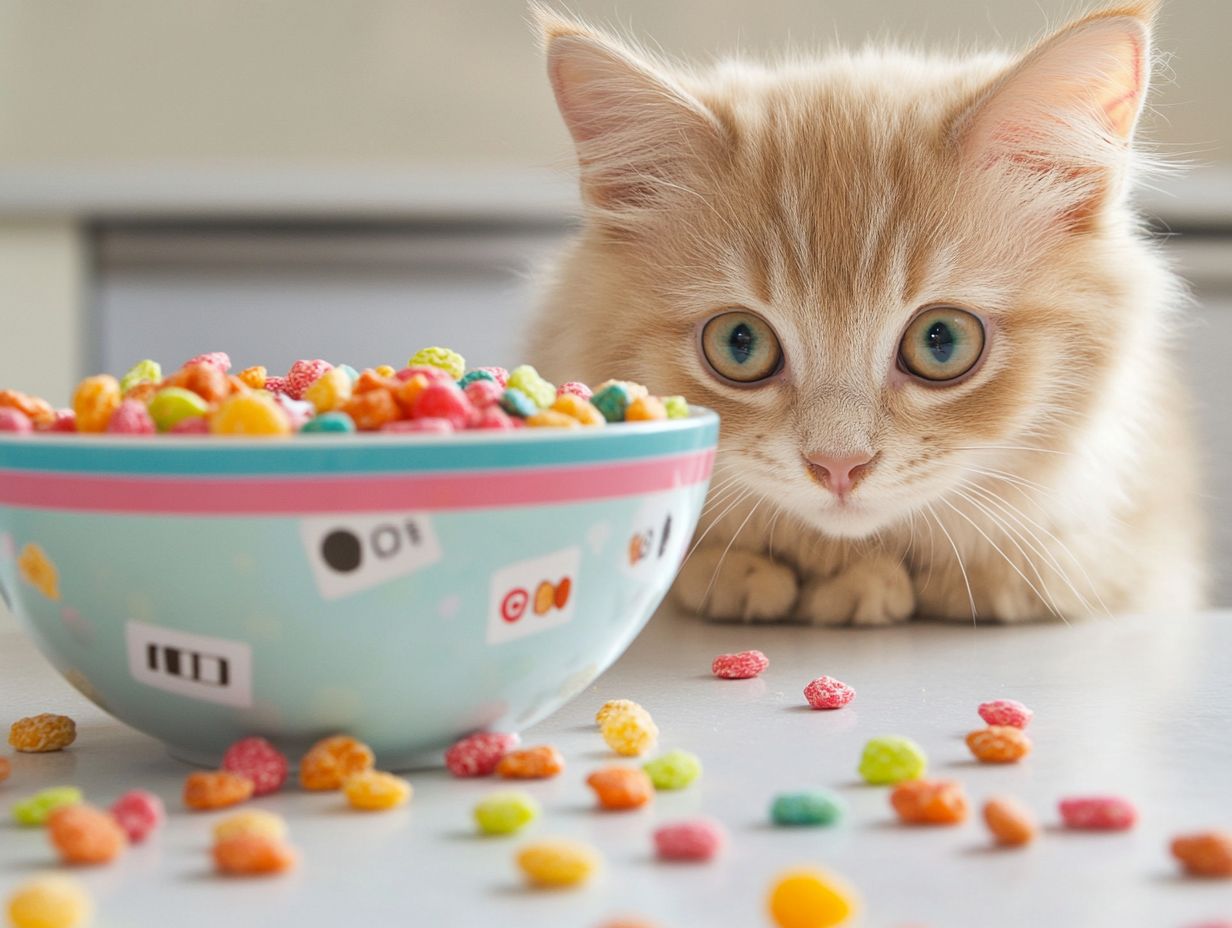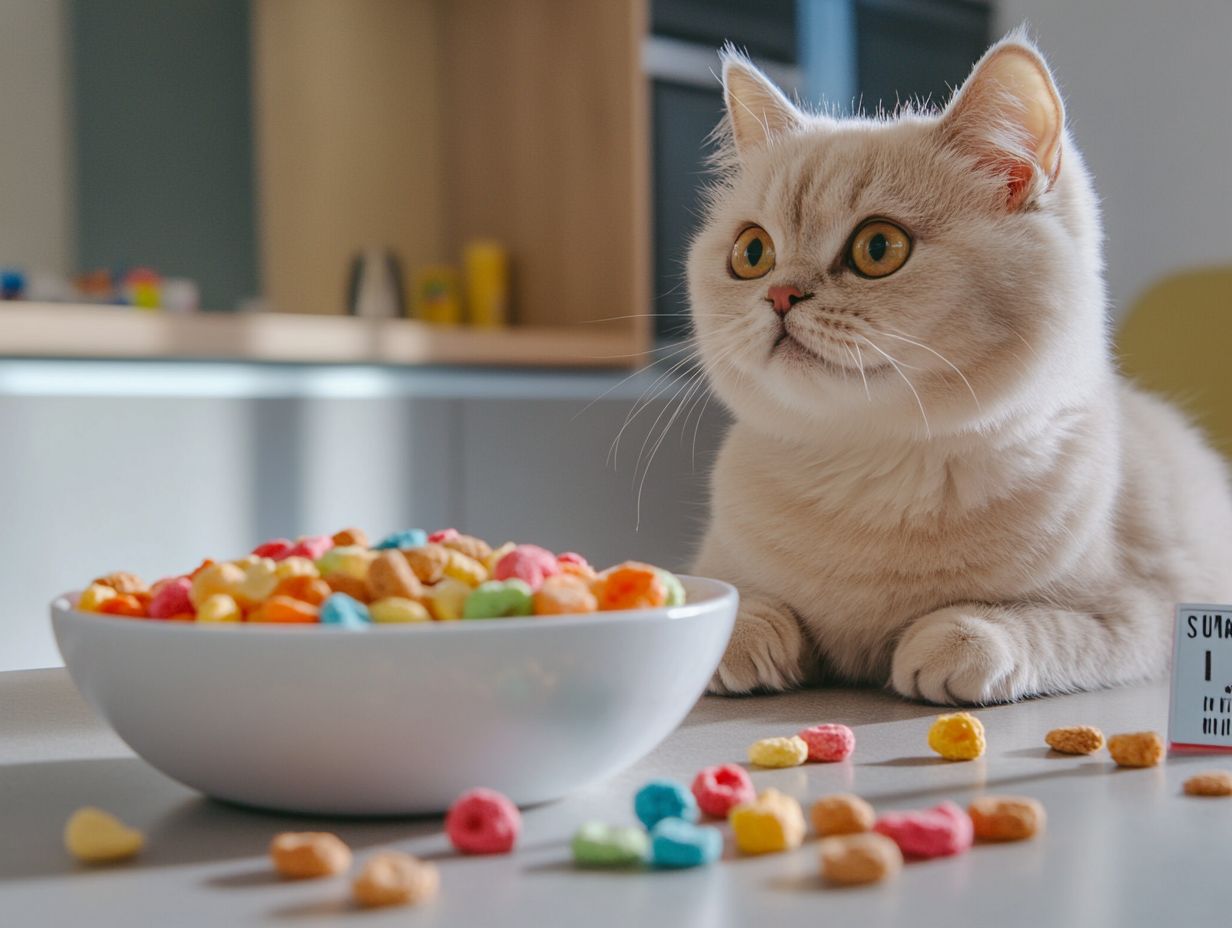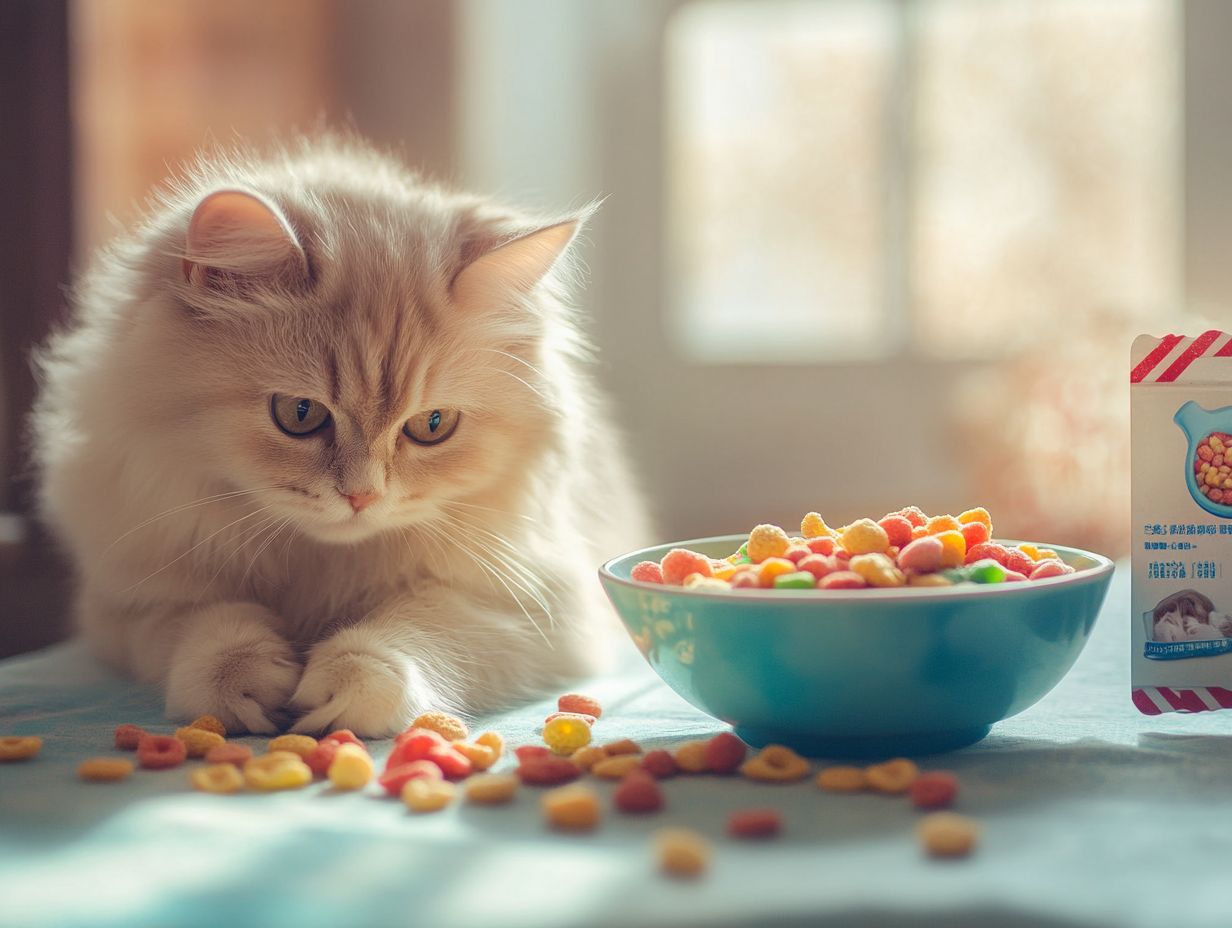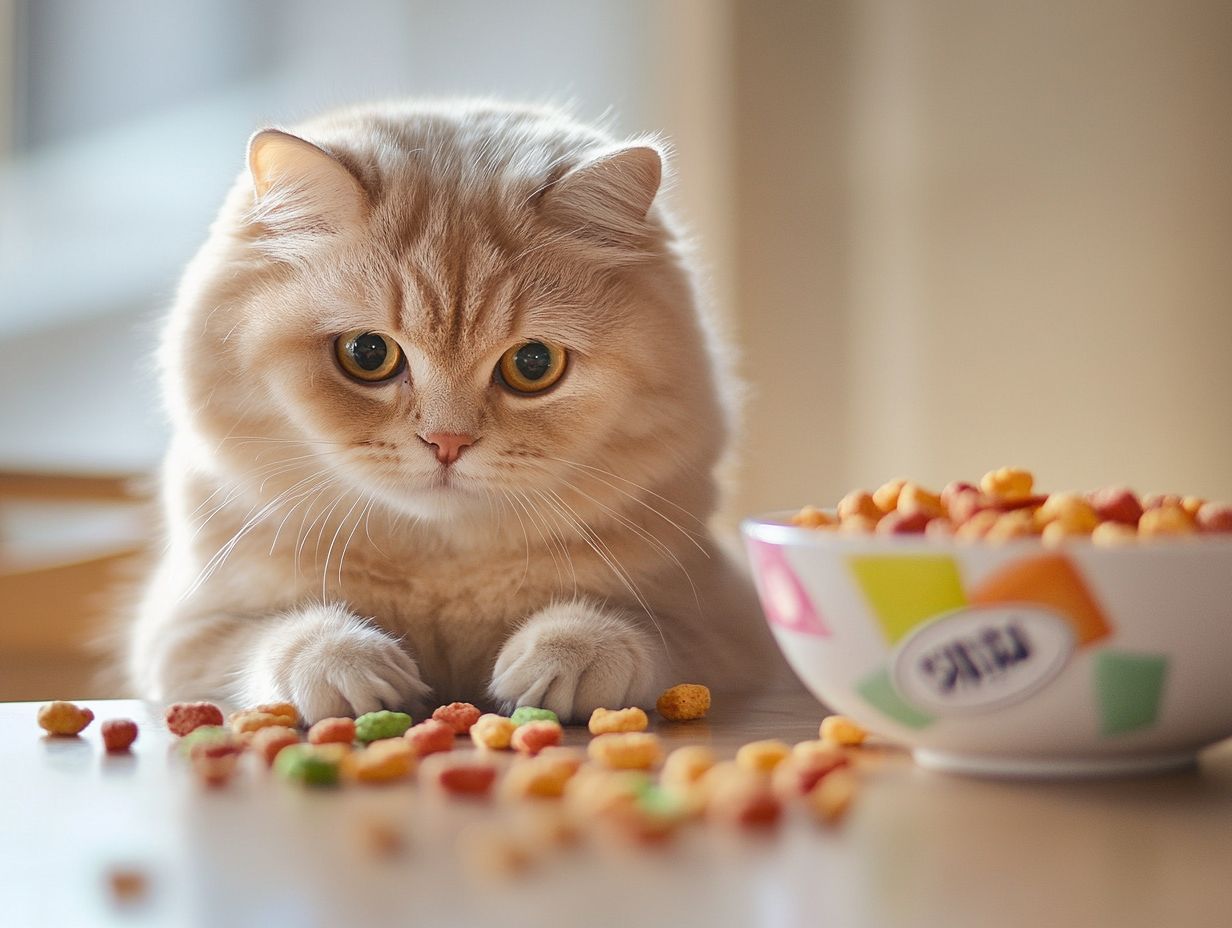Curious about the primary question: Can cats eat cereal? You’re not alone! Consult your vet before introducing any new food to your pet’s diet.
This article explores the nutritional needs of our feline friends, focusing on a meat-based diet and how cereal fits into their dietary requirements.
It discusses the potential risks such as grain intolerance and health concerns like diabetes associated with feeding cats cereal, particularly those that are high in sugar. To provide accurate information, verify nutritional claims of cereals against trusted veterinary sources such as the American Veterinary Medical Association and VCA Hospitals.
Additionally, tips are shared on how to safely introduce small amounts of cereal into their meals, considering food safety and potential lack of nutritional benefit. Offer no more than a teaspoon of cereal as an occasional treat and always consult your veterinarian.
Join us as we uncover the truth behind this common question!
Key Takeaways:

- Cats have specific nutritional needs and dietary requirements that should be met through a balanced diet, rather than relying on cereal as a main source of nutrition.
- Feeding cereal to cats can pose potential risks and health concerns, including digestive issues such as diarrhea and constipation, and nutrient deficiencies. It is best to avoid offering cereal as a regular part of a cat’s diet.
- There are many healthier snack options for cats, such as cooked lean proteins like chicken or turkey, and safe fruits and vegetables like small pieces of cooked carrots or peas. These alternatives can provide necessary nutrients and variety in a cat’s diet.
Overview of Cats’ Diet
Cats have specific dietary needs that are essential for their overall health and well-being, as they are obligate carnivores. Their nutritional requirements must be met with a meat-based diet rich in specific proteins, omega-3 fatty acids, and antioxidants.
Unlike other pets, cats possess a unique digestive system that cannot efficiently process large amounts of grains or cereals; including these in their diet can lead to health issues like grain intolerance. Proper nutrition is critical for preventing conditions such as diabetes and obesity, making it important to follow veterinarians’ recommendations for a feeding guide tailored to each individual cat’s circumstances.
Nutritional Needs and Dietary Requirements
- Essential Proteins: Crucial for muscle development and energy production.
- Vitamins A, B, and E: Important for healthy skin and coat, immune system support, and proper vision.
- Minerals (Calcium and Phosphorus): Aid in bone health and metabolic functions.
- Fiber: Supports healthy digestion.
By ensuring that these nutrients are adequately provided, cat owners can greatly enhance their pet’s digestion, support robust energy levels, and contribute to an overall sense of well-being.
The Safety of Feeding Cereal to Cats
Feeding cereal to cats raises dietary concerns because, although most cereals are not toxic, they may not offer adequate nutritional benefits that obligate carnivores require. While small amounts are unlikely to harm your cat, high-sugar cereals can contribute to health issues such as obesity and diabetes, highlighting the importance of vet advice.
Therefore, it is essential to consider carefully what food is provided. Understanding the safety of grains for cats is crucial for maintaining food safety and ensuring that their digestive system functions properly.
Potential Risks and Health Concerns

According to veterinarians, feeding cereal to cats carries certain risks, including potential digestive problems due to gluten intolerance or other sensitivities. These grains can disrupt a cat’s delicate digestive system, leading to symptoms such as diarrhea or constipation, and could impact overall cat health.
In some cases, even small ingredient components can trigger an inflammatory response, resulting in discomfort that may escalate into more serious health issues. Cats are obligate carnivores that thrive on a diet high in protein and low in carbohydrates; therefore, replacing meat with grains can lead to nutritional deficiencies.
Safety Guidelines for Feeding Cats
To safely introduce any new food, including cereal, to your cat’s diet, follow these steps:
- Consult your veterinarian before introducing cereals or any new food.
- Start with a very small amount (no more than a teaspoon).
- Observe your cat for any adverse reactions over 24 hours.
- If no negative symptoms occur, you may gradually increase the amount, but only as an occasional treat.
- Always prioritize a balanced, meat-based diet for your cat.
Conclusion
In summary, while cats may occasionally nibble on cereal, it is not a suitable staple in their diet. The risks associated with feeding cereal, particularly high-sugar varieties, cannot be overlooked. A meat-based diet is crucial for maintaining their health and preventing potential health issues. Always consult with your veterinarian for tailored dietary advice for your feline friend.
Can cats eat cereal? While cats can enjoy cereal in small amounts, it is essential to prioritize a meat-based diet for their overall health. Regular monitoring of their stool consistency and consulting with a veterinarian before making any significant dietary changes is crucial for pet owners.
Alternatives to Cereal for Cats
Healthy snack alternatives to cereal for cats should align with their dietary needs and complement their meat-based diets, considering options like the Hepper NomNom Cat Bowl for feeding.
Nutritious Snack Alternatives to Cereal for Cats
Nutritious snack options for cats include small amounts of safe fruits like 1-2 small pieces of apples and pears, which provide essential nutrients without disrupting their meat-based dietary needs. Additionally, vegetables such as 1 teaspoon of carrots and peas can serve as wholesome treats, adding fiber and vitamins to a cat’s diet, according to veterinary sources.
Occasionally incorporating small portions of plain cooked fish (avoid tuna) or plain cooked chicken can delight their taste buds and offer a protein boost. It is crucial for cat owners to ensure that any treats align with their pet’s overall dietary requirements, enhancing rather than disrupting the balance of their meals. Note: hard treats can pose a choking hazard, especially for older cats.
By carefully selecting these snacks, guardians can promote healthier habits and enrich their beloved companions’ nutritional intake.
How to Properly Feed Cats Cereal
Practicing portion control and feeding frequency for cats consuming cereal is essential to ensure they do not exceed the recommended limits for cat food intake.
Portion Control and Frequency

Proper portion control and the frequency of feeding cats cereal are crucial to preventing health issues and ensuring they receive the necessary nutrients. To achieve this, it is essential to understand your cat’s individual dietary needs, which depend on factors such as age, weight, and activity levels.
Regular checkups and consultations with your veterinarian will provide valuable insights into what your cat should be eating and how much cereal, if any, should be included in their diet. A helpful guideline is to ensure cereal does not constitute more than 10% of their daily caloric intake using a measuring cup.
Establishing a consistent feeding schedule will promote healthy eating habits and make it easier to monitor their health and adjust portion sizes as needed.
Final Thoughts and Recommendations
While cereal can be safe in small amounts as a treat, it is crucial to prioritize a meat-based diet and follow veterinary advice for optimal feline health. Cats are obligate carnivores, meaning their physiology is best suited for protein derived from animal sources, which is critical for their health.
Therefore, cat owners should always focus on incorporating high-quality, protein-rich foods into their pets’ diets. Plus, ensuring that cereals are served in moderation, regular consultations with veterinarians are advisable to tailor the diet to their cats’ specific needs. For more information, check out this article on whether cats can eat cereal safely.
Simple steps, such as reading ingredient labels and choosing wet food, can enhance hydration and overall well-being. By being proactive and informed, cat owners can help their pets thrive while still allowing for the occasional treat.
Frequently Asked Questions
Can cats eat cereal?
Yes, cats can enjoy cereal in small quantities as a treat, but it should not constitute more than 10% of their daily caloric intake.
Is cereal safe for cats to eat?

Cereal is generally safe for cats to eat in small amounts, but it should not be a staple in their diet.
What types of cereal are safe for cats?
Plain, unsweetened cereals like Cheerios or Corn Flakes are considered safe for cats to eat. Always check the ingredients for any potential harmful additives or flavorings.
Can cats eat milk and cereal?
Milk and cereal is not a recommended meal for cats as most cats are lactose intolerant, leading to digestive issues and discomfort.
Why is cereal not recommended as a main part of a cat’s diet?
Cereal does not provide the necessary nutrients for a cat’s diet and can contribute to obesity and other health issues. It is important for cats to have a balanced, species-appropriate diet.
What should I do if my cat accidentally eats cereal?
If your cat accidentally eats cereal, assess the situation to ensure their safety and health. Generally, a small amount is not harmful, but it’s essential to monitor your cat closely.
If your cat has consumed a larger amount or is showing any signs of discomfort or illness, such as vomiting, diarrhea, lethargy, or unusual behavior, contact your veterinarian for advice.
Potential Risks of Cereal Consumption
Cereal can contain sugars and additives that may be harmful to cats. Some cereals may also include ingredients like chocolate, raisins, or xylitol, which are toxic to pets. Always check the ingredient list before allowing your cat to consume any human food.
Immediate Actions to Take
After your cat eats cereal, monitor them for any symptoms. It’s important to keep cereal and other human foods out of reach to prevent accidental ingestion. If your cat shows any concerning symptoms, do not hesitate to seek veterinary care.
Guidelines for Cereal Consumption
For an average cat, consuming more than a few pieces of cereal may be considered a “large amount.” Generally, a few pieces for a small cat could be around 1-2 grams, while larger cats might handle slightly more. Always consult your veterinarian for personalized advice based on your cat’s size and health.
Safe Alternatives for Treating Your Cat
If you are looking for alternatives to treat your pet, consider options like small pieces of cooked chicken, fish, or commercially available cat treats that are specifically formulated for their dietary needs.
Always consult your veterinarian if you’re unsure about your cat’s health after dietary accidents.